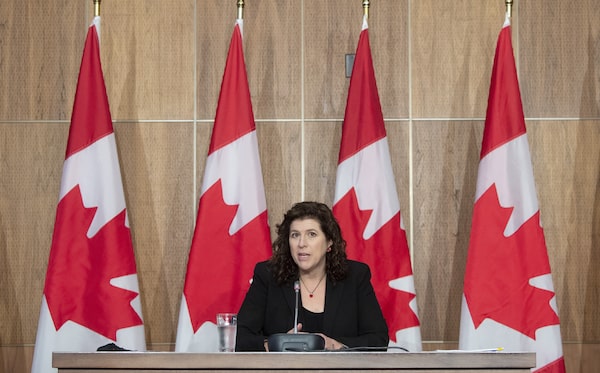
Public accounts show Auditor-General Karen Hogan originally signed off on the public accounts on Sept. 9, but then signed off to a change on Nov. 19 that added billions in new spending related to Canada’s First Nations child-welfare system more than eight months after the fiscal year ended.Adrian Wyld/The Canadian Press
The Liberal government reopened last year’s audited books in November to add nearly $10-billion in spending, a move that required a second sign off by the Auditor-General for the first time under current public-sector accounting rules.
The federal government’s public accounts for the 2020-21 fiscal year, which break down all spending for the year that ended March 31, were tabled Tuesday this week, on the same day that Finance Minister Chrystia Freeland released a fall economic statement.
The public accounts show that Auditor-General Karen Hogan originally signed off on the public accounts on Sept. 9, but then signed off to a change on Nov. 19 that added billions in new spending related to Canada’s First Nations child-welfare system more than eight months after the fiscal year ended.
The Auditor-General’s office told The Globe and Mail Wednesday that it is the first time the office has provided a “dual-dated” audit opinion under current accounting rules. “Looking back since the introduction to accrual accounting in 2003, there were no dual-dated audit opinions on the government’s consolidated financial statements,” the office said.
Federal government oversight failed to protect migrant workers from COVID-19, Auditor-General says
Ottawa isn’t properly monitoring or tracking its COVID-19 border rules, Auditor-General says
Non-partisan fiscal observers – including UBC economist Kevin Milligan and Sahir Khan, executive vice-president at the University of Ottawa’s Institute of Fiscal Studies and Democracy – said the fact that the Auditor-General signed off on the move would suggest all the rules were followed. That said, they both said that backdating the new spending helps the Liberals because it gives the government room to show a smaller deficit in the future or to approve new spending.
“Politically, is it useful to kind of front-end load those expenditures so you can stay on a declining debt-to-GDP track? Of course it is. But I think their accounting treatment was appropriate in this,” said Mr. Khan, who is a former senior financial official with several federal departments, as well as a former assistant parliamentary budget officer.
Conservative MP Kelly McCauley said in an interview that the accounting move warrants a more complete justification. He also said the government should not have waited this long to release the full accounting of how federal tax dollars were spent in the 2020-21 fiscal year, which covered the height of the government’s pandemic response.
“The books are tabled very, very late, and then you find out they’ve been reopened after they’ve been audited to put in some spending. It just reeks of lack of transparency,” he said in an interview. “I would like very much to hear from the Auditor-General justifying reopening the books and the reason why.”
The issue relates to how the federal government is accounting for the decision it announced on Monday that it had set aside $40-billion to compensate First Nations children and reform Canada’s child-welfare system. The funding is not a settlement, but is tied to continuing government efforts to settle class-action lawsuits and a court battle over Canadian Human Rights Tribunal (CHRT) findings.
Tuesday’s fall economic statement revealed that the $40-billion is spread across seven years and is a revision to a previous decision to set aside nearly $16-billion over that same period to cover that potential legal liability. The update showed that while $6.4-billion had been booked for the 2020-21 fiscal year that ended March 31, that has been revised upward to $16-billion, for a net increase of $9.6-billion.
Tuesday’s fiscal update said the deficit for the 2020-21 fiscal year was $327.7-billion, which was smaller than the $354.2-billion projection in the April budget, even after including the new spending that was added in the November revision.
The update said the deficit for the current fiscal year is projected to be $144.5-billion, compared with the estimate of $154.7-billion in the April budget.
Treasury Board President Mona Fortier’s office said in a statement that the update to the public accounts was driven by a Sept. 29 decision of the Federal Court, which rejected Ottawa’s request for a judicial review of two CHRT rulings related to services for First Nations children.
“The government considered the impact of the court ruling and concluded that the change in estimated legal liability warranted an adjustment, and the financial statements were revised accordingly to include the impact of the court ruling,” the minister’s office said, adding that the decision complied with public-sector accounting standards.
“The Auditor-General then audited the revised estimated contingent liability, dual dated her audit report date to reflect the extension of her audit, and maintained the unmodified opinion on the government’s financial statements.”
The public accounts include a note referencing the Sept. 29 Federal Court decision and the fact that it was appealed by the government on Oct. 29. The note states that the Nov. 19 revision represents “the government’s best estimate of the contingent liability” as of that date.
Know what is happening in the halls of power with the day’s top political headlines and commentary as selected by Globe editors (subscribers only). Sign up today.
 Bill Curry
Bill Curry